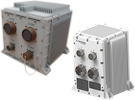Master Data Acquisition Unit
The Master Data Acquisition Unit is installed inside the small space launch vehicle, this unit collects status information using analog sensors and digital data, and transmits it to the ground.
Aerospace
Status information monitoring, orbit tracking, flight termination and power distribution/protection
through a variety of electronic equipment installed on space launch vehicles.

Master Data Acquisition Unit
The Master Data Acquisition Unit is installed inside the small space launch vehicle, this unit collects status information using analog sensors and digital data, and transmits it to the ground.

Slave Data Acquisition Unit
The Slave Data Acquisition Unit is installed inside the small space launch vehicle, this unit collects status information using analog sensors and digital data, and transmits it to the Master DAU (Data Acquisition Unit).

Remote Data Acquisition Unit
The Remote Data Acquisition Unit is a small measurement device that can be applied in a limited mounting space, which collects status information using analog sensors and digital data installed inside a small space launch vehicle, and transmits it to the Master DAU (Data Acquisition Unit).

Network Switch
The Network Switch applies a redundant configuration to ensure system reliability, and connects the electric system and devices that make up the avionics system network.

Pyro-technic Drive Unit
The Pyro-technic Drive Unit detonates pyrotechnics to perform tasks such as stage separation, ignition of acceleration motors, ignition of reverse-thrust motors, satellite separation and fairing separation during the flight of a space launch vehicle.

Mission Control Unit
The Mission Control Unit collects data from avionics-related parts of the space launch vehicle and controls them, taking into account factors such as trajectory, velocity and environment.

Power Distribution Unit
The Power Distribution Unit distributes, protects, and monitors the power supplied from the power source to the pyrotechnic devices mounted on each stage of the space launch vehicle.

Integrated Navigation Unit
The Integrated Navigation Unit combines inertial sensors and navigation in order to monitor the position and direction of space launch vehicle.

Autonomous Flight Termination Unit
The Autonomous Flight Termination Unit is a self-autonomous-type flight termination unit that autonomously evaluates flight integrity through real-time status information of the in-flight space launch vehicle and predetermined mission parameters, and performs flight termination actions in the case of abnormal or emergency situations.

Flight Termination Receiver
The Flight Termination System receives and decodes flight termination commands from the ground and performs power control and explosive functions.

Thruster Control Unit & Roll Control System
The Thruster Control Unit and Roll Control System control the direction and positioning of a space launch vehicle through a three-axis positioning control system.

Engine Control Unit
The device that measures various sensor signals and manages drive systems such as valves and motors to control the launch vehicle engine.
Avionics
Various avionics-related equipment for communication, monitoring, measurement and control of manned and unmanned aircraft.

SCDAU (Stackable Compact Data Acquisition Unit)
The SCDAU is a stackable-type data acquisition unit that can employ multiple modules, as per the user's requirement. This unit processes and analyzes collected data to provide necessary information to the user. It also provides large-scale data processing and storage capabilities, as well as real-time data monitoring.

Airborne DAU (Airborne Data Acquisition Unit)
The Airborne DAU is a device that collects and analyzes various signals generated during the operation and testing of aircraft. This unit collects and analyzes various information from aircraft, such as flight conditions, system performance and environmental conditions, to maintain safety and improve operational efficiency during flight.

Airborne Network Switch
The Airborne Network Switch is a network device for data transmission in aircraft, providing the infrastructure for smooth and reliable communication between the various electric devices connected throughout the aircraft.

HUMS (Health and Usage Monitoring System)
The HUMS is a system that continuously monitors and analyzes the health status and usage patterns of machines or equipment to be utilized for predictive maintenance and fault prevention. This unit monitors the engine, gear, rotor, and other critical points of aircraft or ground vehicles and analyzes their condition, providing data for predictive maintenance and fault prevention. This improves safety and extends the lifetime of the equipment.

FCC (Flight Control Computer)
The FCC works in conjunction with various automated systems to adjust the aircraft's positioning during flight and maintain stability and controllability. It is generally composed of redundant duplexing or tripleization system to enhance reliability.

Fixed TGS (Fixed Telemetry Ground Station)
The Fixed TGS is a system installed at a designated location in order to collect and analyze flight data. This system includes tracking antennas, receivers and the data analysis system, and helps monitor the safety and performance of aircraft, providing detection and support for immediate action.

Mobile TGS (Mobile Telemetry Ground Station)
The Mobile TGS is a movable system. This system can be quickly deployed and operated for tests conducted in specific areas. This system also can support various types of mobile telemetry ground stations depending on the scale of the test and the number of analysts.